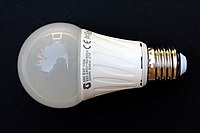
Photo from wikipedia
Adenophora triphylla (Thunb.) A.DC., a well-known herbaceous medicinal species, has been reported to protect against human obesity, cancer, and inflammation. Supplementary lighting is a practical strategy to improve crop quality,… Click to show full abstract
Adenophora triphylla (Thunb.) A.DC., a well-known herbaceous medicinal species, has been reported to protect against human obesity, cancer, and inflammation. Supplementary lighting is a practical strategy to improve crop quality, especially at a propagation stage. However, there has been no study available on the optimal supplementary light source for the commercial production of A. triphylla seedlings. In this study, plug seedlings were cultivated in a greenhouse for four weeks under an average daily light intensity of 490 μmol·m−2·s−1 PPFD coming from the sun and a supplemental lighting (16 h per day) at 120 μmol·m−2·s−1 PPFD provided by high pressure sodium (HPS), metal halide (MH), far-red (FR) light, white LED (red: green: blue = 2:4:3, LED-w), or mixed (red: green: blue = 4:1:4) LED (LED-mix). The results showed that LED-mix, with a higher percentage of red and blue light, substantially promoted seedling growth compared to other treatments by increasing stem diameter, biomass, specific leaf weight, and root to shoot ratio. The LED-mix also promoted accumulation of soluble sugar, starch, and chlorophyll in the tissue and increased contents of total phenols and flavonoids. Moreover, stomata density and pore area per leaf area under the LED-mix were remarkably greater than those under other treatments. Furthermore, the Western blot analysis revealed that the expression of photosynthetic protein, D1, was notably enhanced by the LED-mix as compared with other light sources. In addition, the LED-mix alleviated the oxidative damage of seedlings by improving enzymatic and nonenzymatic antioxidant systems. Collectively, these results suggest that the LED-mix was the optimal supplementary light source for the production of highest quality A. triphylla seedlings.
Journal Title: BioMed Research International
Year Published: 2019
Link to full text (if available)
Share on Social Media: Sign Up to like & get
recommendations!